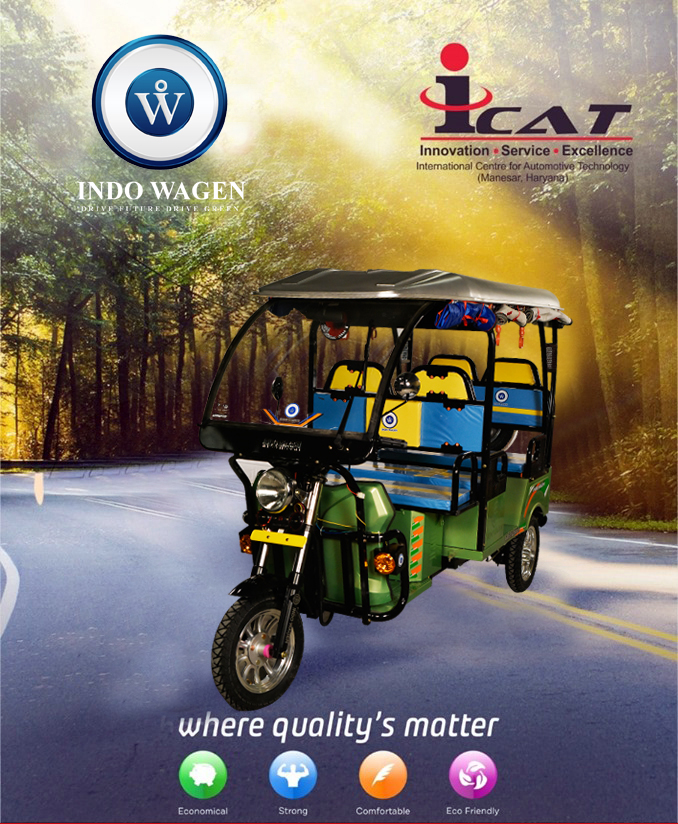e rikshaw

Well before the Government of India announced its intention to have an all-electric fleet by 2030; a three-wheeled retrofitted battery rickshaw was overwhelming the Indian cities. In 2013, in Bengal, Including Kolkata, the number of electric rickshaws employing on the streets was over 1,00,000. India has consistently been home to the largest market for three-wheelers and comparable modes, as they provide a truly necessary answer for motorized portability, which is affordable and frequently available.
At first, launched in Bengal during early 2010 with an objective to eventually phase out physically saddling cycle rickshaws, the e-rickshaws presented themselves as an affordable and clean mode of versatility that had the immense potential of overcoming any issues of first and last-mile connectivity. In Bengal, these battery fitted three-wheelers were able to provide the truly necessary first and last-mile access to the area, which received a mixed response; while it was welcomed by the passengers, the absence of regulation triggered concern for the authorities. The e-rickshaws were additionally spreading to other Indian cities, for example, Lucknow, Amritsar, Ahmedabad, Kochi, Bhubaneshwar, Patna, etc. In the case of cities like Gaya and Jamshedpur, the e-rickshaws provided a para-travel answer for connecting remote villages to cities. The spread and acceptance of the electric rickshaws became inevitable. TERI is likewise progressing in the direction of encouraging and accelerating the selection of four-wheeled passenger electric vehicles in India under ‘Detailed Study on Promoting Electric Mobility in India’.
While e-rickshaws’ development was sporadic, there wasn’t any clear regulatory framework for the registration of these vehicles. In the wake of the exponential development and problems, for example, congestion, the Government of India amended the Motor Vehicles Act (MVA) in December 2015 and defined e-rickshaws and e-trucks. Following the amendment, authorities of Bengal, Delhi, Gujarat, and Pondicherry came up with procedures to regularize these vehicles.
In spite of being surrounded by a variety of controversies, for example, lethal accidents caused at the unauthorized charging station and street accidents, e-rickshaws have witnessed an unrestricted development on Indian streets. The absence of regulation coupled with their sporadic expansion has come to symbolize the yawning breaks in the nation’s inflexible regulatory framework that seem to create more problems than they fix. These vehicles are widely noted for conveying more than the prescribed number of passengers i.e. 4 and the components installed in the vehicle aren’t verified. Agencies like ICAT and ARAI do control the endorsement of assembly lines and vehicle design permits; however, due to the absence of control on the congruity of creation, inadequate components continue to be used widely by manufacturers. Moreover, these vehicles run on batteries that thusly put extra strain on the overtaxed electricity lattice. An average electric rickshaw takes up to 7-7.5 units of electricity, which is charged domestically or in some cases electricity is consumed through unregistered sources. The DISCOMs acquire losses of right around 20 lakhs per day in Kolkata alone.
e-rikshaw Considering the present scenario of electric versatility in India, wherein the dominant part on-street fleet is constituted by electric bikes and the e-rickshaws, ensure that this segment satisfies the objectives of value and safe items. Given that our interface with electric portability has essentially started with e-rickshaws, we should address the quality/safety concern. Furthermore, the approach implementation process will be key in driving the agenda of change of open vehicle modes from conventional technology to electric. This won’t just require inter-departmental coordination however it would likewise be significant for different stakeholders to energize together to achieve the target. Given the unique situation of India in terms of its demand for these vehicles and the technological ability to manufacture these, it would create employment opportunities as well as lead to self-sufficiency. Neighborhood producing needs to go with or even precede the quick increase.
Changing the versatility sector for a diverse country, for example, India would have consistently been a Himalayan undertaking. Hence, it is imperative that phased mandates in cities over time for 3-wheelers could be one of the biggest opportunities to move to pure electric vehicle technology. A comparable iteration has additionally been indicated through the NITI Aayog report-‘India Leaps Ahead: Transformative Solutions for All’ that, it is the low hanging organic products that need to be captured immediately. TERI’s recently launched report ‘Electric Mobility Paradigm Shift: Capturing the Opportunities’, in partnership with YES Bank, additionally makes several strategies and budgetary recommendations to upscale the reception of EVS in India. The trend in EVs in India, since 2009-10, indicates that it is largely the bikes and three-wheelers that provide the speedy chance or which are likely to be readily accepted in the market. However, the question still remains on how to bring electric rickshaws inside the regulated ambit as these e-rickshaws have developed and expanded by market and not by arrangement instruments. Therefore, it becomes significant that the arrangement plan is coupled with coordination among nodal agencies to screen activities at a container India level. This will ensure that the current momentum does not lose steam and the efforts can be sustained, accordingly enabling the nation to achieve its e-portability vision collectively by overcoming the challenges posed by e-rickshaws.



